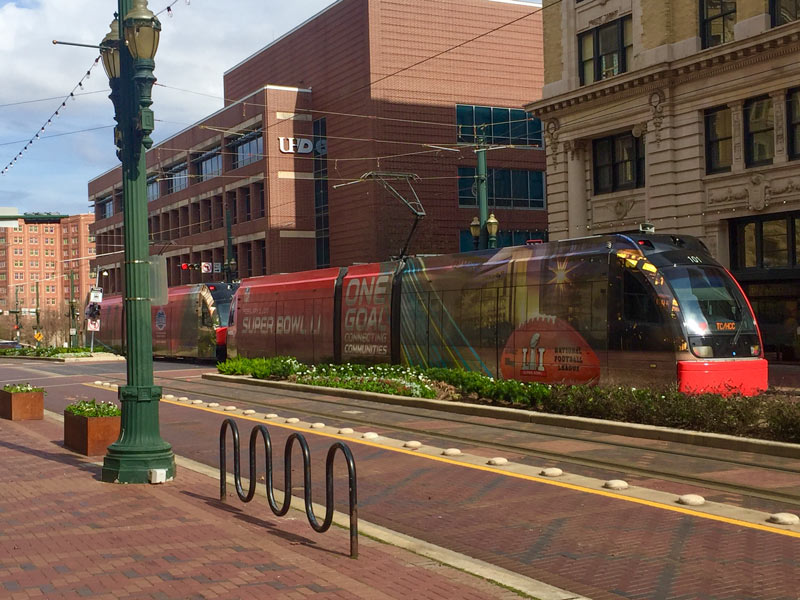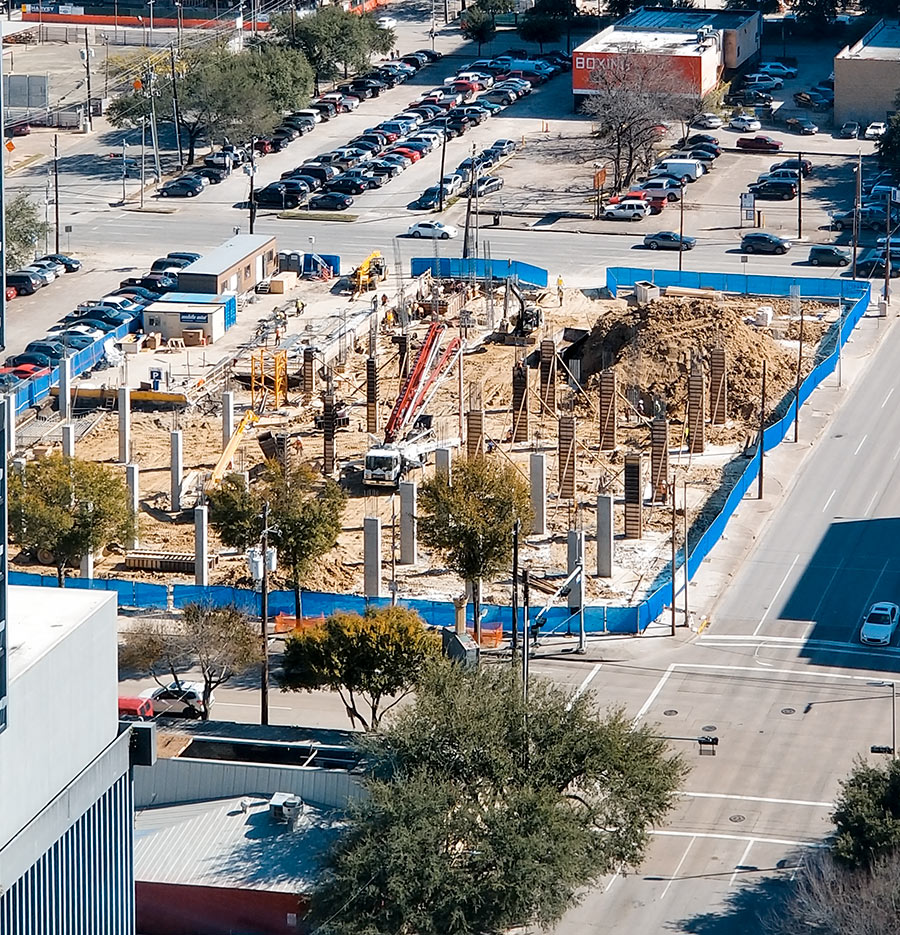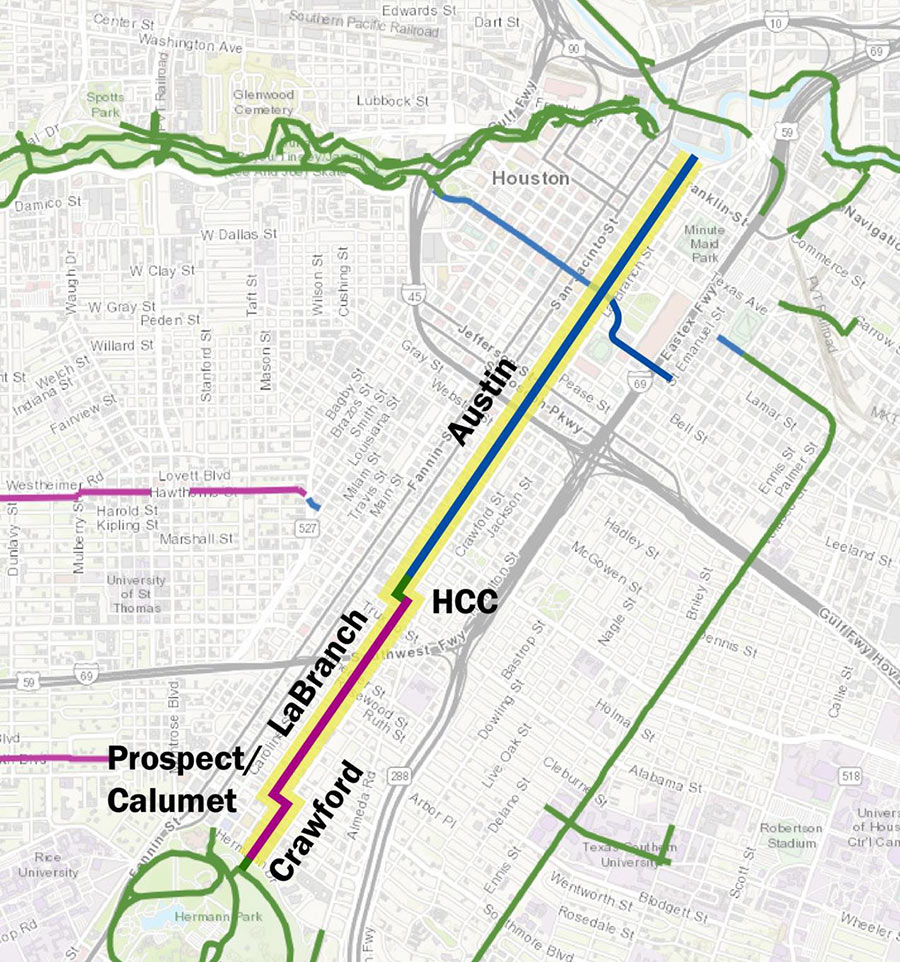HOUSTON LIGHT RAIL BEATS THE COMPETITION IN PEDESTRIAN, BICYCLE COLLISIONS PER MILE  Following 2 deaths over the course of Super Bowl Week and Weekend resulting from cyclist-vs-light-rail collisions, the Chronicle‘s Dug Begley takes a look at how Houston stacks up nationally in terms of train-related accidents. The verdict, after a look through some National Transit Database data: Houston’s rail system has more walker and cyclist hits per mile “than any other major line in the country.” Houston breezes in at less that 100,000 train miles travelled per collision (compared to more than twice as many miles traveled per collision in Dallas, and more than 17 times as many in Boston). Metro CEO Tom Lambert tells Begley it may have to do with Houston’s high number of at-grade crossings and relative lack of barriers to keep people off the tracks. Begley says that the original decision to build the train at-grade isn’t itself unusual given the cost of elevated rail, but notes that “few places outside Houston have built their lines in some of the most congested and pedestrian-heavy areas of their respective urban regions.” [Houston Chronicle; previously on Swamplot] Photo of light-rail train dressed for Super Bowl Week: Christine Wilson
Following 2 deaths over the course of Super Bowl Week and Weekend resulting from cyclist-vs-light-rail collisions, the Chronicle‘s Dug Begley takes a look at how Houston stacks up nationally in terms of train-related accidents. The verdict, after a look through some National Transit Database data: Houston’s rail system has more walker and cyclist hits per mile “than any other major line in the country.” Houston breezes in at less that 100,000 train miles travelled per collision (compared to more than twice as many miles traveled per collision in Dallas, and more than 17 times as many in Boston). Metro CEO Tom Lambert tells Begley it may have to do with Houston’s high number of at-grade crossings and relative lack of barriers to keep people off the tracks. Begley says that the original decision to build the train at-grade isn’t itself unusual given the cost of elevated rail, but notes that “few places outside Houston have built their lines in some of the most congested and pedestrian-heavy areas of their respective urban regions.” [Houston Chronicle; previously on Swamplot] Photo of light-rail train dressed for Super Bowl Week: Christine Wilson





“few places outside Houston have built their lines in some of the most congested and pedestrian-heavy areas of their respective urban regions.â€
Isn’t the most congested area of your urban region the kind of the place you’d want to put it?
I still don’t get why Houston is so incapable of functioning with a very simple train system in a city built for transit, while a place like Milan seems to have no trouble with their spaghetti of light rail/trams sharing the same tiny streets as their cars.
You get what you (don’t) pay for. Had we actually invested in underground or elevated rail like the other systems, we’d see many fewer fatalities. Our state constitution puts all of the tax burden on homeowners and businesses and then arbitrarily caps the tax rate so we end up cutting as many corners as possible to get basic services like transit and road maintenance. I’m all for balanced budgets and efficient government, but we can’t chop off our right arm and expect to still be able to be a star quarterback.
@We Have Only Ourselves To Blame: This article is about Houston being more dangerous than other cities with at-grade rail, not about comparing the risk of at-grade rail to elevated rail or subways. Lots of cities have rail like ours, but they don’t kill as many people as we do.
.
I don’t believe it’s because Houston has more pedestrians close to rail. I think there’s something wrong with us. We are are too risk tolerant. We do dumb stuff people in other cities don’t do.
.
I’m not sure why Houston would attract and/or promote this behavior, but I see it all the time. People don’t seem to understand that the train will not stop for them, or that the consequences will be severe.
I hate to see anyone killed, but if you can’t see or hear a train coming, you are not paying attention, have earphones in, etc….when you are riding/walking across train tracks, maybe you should look to see if there is a train coming — do you walk across a street without looking if cars are coming…people need to pay attention to their surroundings and quit blaming others when they don’t.
@ChrisC, I was just in Milan last week, and thought the same thing. There’s trams everywhere in the central part of the city, and yet they seem to get along fine with cars and pedestrians. They have real bells too!
Pro-train nuts (the same people who promote banning cars and biking to work in 103 degree heat) usually resort to calling the victim “stupid” and “dumb.” That’s a pretty nifty way of avoiding the issue.
Intelligent people who see what’s actually happening here recognize that installing train lines on busy surface streets is a recipe for disaster.
How many people must die to perpetuate your liberal utopian delusions about how people should get around in this city?
Ditto on not wanting to see anyone killed or hurt by getting hit by a train. Yet, if someone is so dumb as to not pay attention to their location – near a train for goodness sake – then it is really a question of personal responsibility. No text, call, video, or music is worth getting hurt or killed.
.
That being said, if the pedestrian is killed, it is a sure bet they won’t make that mistake again. If maimed, they will be as nervous as a cat in a room full of rocking chairs when walking the streets afterward.
i think the problem is the trains look so friendly and sweet like thomas the train so people don’t take them seriously. we should decorate them like mad max like with skulls and chains and stuff so maybe people will stay the hell away.
Realist, Houston also ranks top 5 nationally for pedestrian deaths per capita generally. By your logic, shouldn’t we also be investigating who approved allowing automobiles on busy surface streets, despite it being a recipe for disaster. How many people must die to perpetuate your 1950’s utopian delusions about how people should get around in this city?
Houston beating out the competition once again!
“Houston’s rail system has more walker and cyclist hits per mile “than any other major line in the country.†Houston breezes in at less that 100,000 train miles travelled per collision (compared to more than twice as many miles traveled per collision in Dallas, and more than 17 times as many in Boston). ”
Htown is #1!!!
If the data is broken down per mile, can they at least give us how many miles of rails we are talking about here. Because I bet we have a fraction of the rail lines that Boston and DART has.
The choo choo system is dangerous…hard to tell what’s going on downtown sometimes with the street lights and trains in the roadway plus this is always the fattest city and fat people have a harder time jumping or running when they look up from their phones.
Just wait until the streets are filled with quiet electric cars and trucks. Maybe they should get synthetic whistles, too.
Having lived near the Red Line for many years, I’m not sure why people consider it so dangerous. If you’re walking on the street and paying attention, the train will not sneak up on you. It’s like at work, they say “walking is working.” Some may say this is a stupid phrase or be in disbelief that work is over vigilant, but they want to make sure that you come home in the same condition you left (maybe better).
.
Perhaps downtown where they now have multiple lines, it’s a bit more confusing. In that case, I would say that people slow down and if they’re unsure what to do, take extra time to figure it out. Now, can more be done to protect pedestrians and cyclists in our city? Likely, yes.
.
Driving seems a whole lot more dangerous. I see people texting or looking at their phones every single day. I’m amazed that more people aren’t killed by inattentive drivers.
Other systems, including Dallas and Boston, have substantial lengths of grade-separated track, whereas Houston has very little. There are places all along this at-grade system where jaywalking across the tracks saves a pedestrian some time — and as we know from our experiences with freeways — there do exist pedestrians that are willing to take their chances on a mad dash. Add to that some pressure because perhaps they want to get to a platform to catch a train that’s about to depart without having to wait for the next one…risks will be taken and mistakes will be made.
.
Also, although its average velocity is only that of local buses, our light rail has quite a bit higher capacity than buses or trams, and numerous local bus routes have been consolidated or truncated along light rail corridors. This results in high ridership per mile, but it also raises the average number of transfers per trip, and predictably results in a lot more people just milling about in proximity to rails. This should be expected to correlate with accidents. If you look at crime maps, it also correlates with incidences of reported crime. Wherever there are people, there will be people-related problems.
.
Now indeed, it is a valid concern that safety can be engineered. It costs money. In this case, safety would’ve gone hand-in-hand with higher average operating speeds, congestion reduction, and the option of reducing headway between vehicles during periods of peak use without inducing gridlock on local streets. But…METRO hasn’t got inexhaustible financial resources. They wanted to build *something*. They achieved that *something*, (and a few other adverse *somethings*) and now they have even fewer resources than ever. The better system was never on the table, and nor will it ever be unless the legislature makes reform of the transit agencies a high priority.
I say we should embrace this as a new extreme sport “train dodging” and draw extreme sport tourist to Houston so we can keep the tourist momentum going from Super Bowl.
I’m not sure I agree with Niche’s take on limited funds, etc. You get the system the stakeholders want. Dallas DART is governed by a board with a majority of seats held by suburban politicians. Houston METRO has a board that’s always majority-City of Houston.
.
Hence, DART is set up as suburb-to-city, with fewer stops and a lot of 65mph track. METRO is set up as inner-city, with more stops and slower track. It’s closer to older networks like Boston’s Green Line than it is to systems west of the Mississippi, which mostly follow the Dallas model.
.
There is an argument for Houston having regional rail which can get you to Katy, Sugar Land, Baytown, or Galveston at speeds comparable to free-flow traffic. But building that requires the big suburban cities to buy in, and getting their buy-in would require the City of Houston to relinquish control. Which isn’t happening.
.
If you want fast trains in Houston, you need to set up an overlay agency which is specifically tasked with fast trains. Seattle did this (“Sound Transit” sits on top of four county and city agencies) and while I have many quibbles with the engineering of their system, it is up and running and is acceptably fast:
https://www.google.com/maps/@47.4651829,-122.2706113,3a,49.3y,272.75h,85.74t/data=!3m6!1e1!3m4!1su-LYvDajPmksX0YfgPn98w!2e0!7i13312!8i6656
We already do have an overlay agency in the form of the Gulf Coast Rail District. We just have no mechanism by which to fund it.
@ Purple City: METRO, such as it exists now, is financially hamstrung. It is in no position to undertake another major project in the near future, especially now that their engineering studies have expired and would have to be begun again from scratch, and in particular if the goal is to grade-separate a line through an urban area or to ‘fix’ existing lines by replacing them. A legislative solution would be required. You’re right that there doesn’t exist the political will and that it’s not just selling the idea to suburban constituencies, but also breaking the City of Houston’s fiefdom. It also has a lot to do with legislative priorities; Texas’ brief biennial legislative session gets astro-turfed by Dan Patrick’s bathroom bills, etc., in lieu of substantive reforms to state-chartered entities.
.
You mentioned that the stakeholders get what they want. I also disagree with that. METRO’s management is appointed by appointees of mayors that campaign on a diverse array of issues, with transit not high on the list. Important referendums on projects that ought to be offered a la carte or in discrete packages of similar and complementary projects get bundled together to try and narrowly achieve a predetermined outcome. The process is neither transparent or accountable to the vast majority of stakeholders.
Well, yes. Having built a bunch of LRT lines, Metro has no money for more. My point was, I don’t think the original routing (of what’s since been built) was about funds so much as a specific desire by the City to have trains in the median of major thoroughfares going through Inner Loop neighborhoods.
.
Paved track is expensive, and something like the Fulton-Northline run with its 10mph reverse curves was arguably more expensive than say, running it along the western edge of the Hardy Toll Road Extension. That would’ve gotten you a 65mph straight shot, but at the expense of (i) half your walk radius within Fifth Ward/Near Northside, and (ii) the futuristic streetcar aesthetic, which is a big part of what the City wanted (going back to the original ~2000 promo materials with pictures of Strasbourg trams).
Yes, aesthetics were a big part of the initial decision-making process. (The wonderful thing about pinning poor design on aesthetics is that one can meekly imply that all such considerations were perhaps made deliberately rather than from ignorance, mental illness, neglectfulness, or for some self-serving purpose. It is a very polite term.)
.
To be clear, I’m not necessarily advocating a Dallas-like system over Houston’s system. It’s my opinion that a combination of Park & Ride, BRT, and local express buses would’ve been far more effective for the money spent. That goes for both cities. My only purpose was to provide a more objective explanation for METRO’s safety record, to absolve any one city-full of people as being collectively prone to Darwinism-by-small-train, and to try to dash any and all hopes with overwhelming cynicism that this pattern can be stopped without an politically-impossible degree of intervention.
Yeah, an apples-to-apples comparison would pit the Houston systemwide average up against only the street-running segments of other cities. We’re in agreement there.